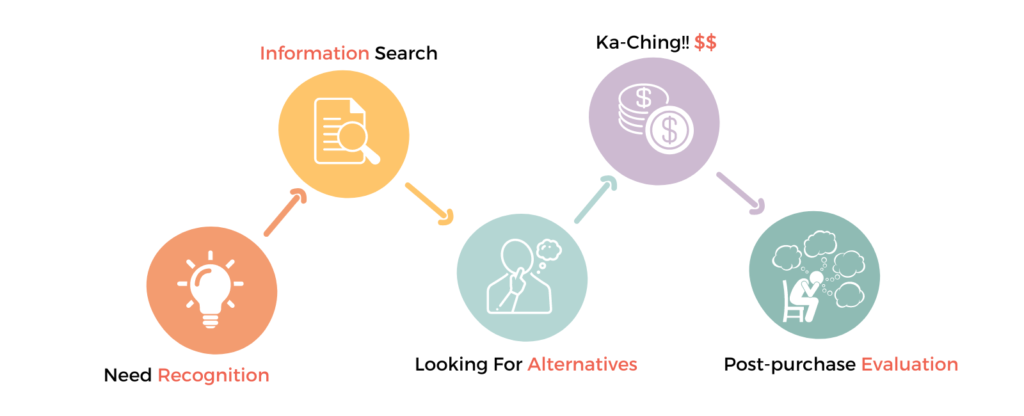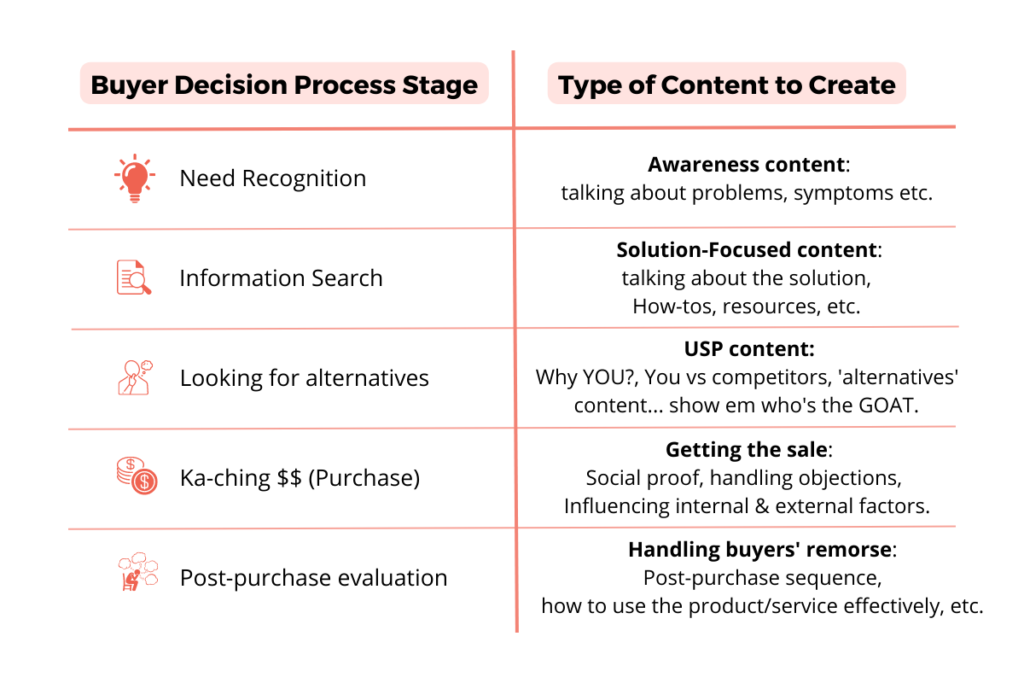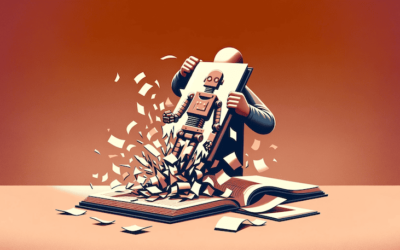When was the last time you purchased something?
Was it a quick decision or a planned purchase?
Ever wondered why?
Why do you sometimes make a quick buying decision?
And other times?
You wait months before buying something.
Every purchase, besides impulsive ones, involves a fascinating process.
The buyer’s decision process!
A fascinating journey filled with twists and turns that consumers embark upon when making a purchase.
What is that process?
What are the factors influencing it?
Where does your marketing come in?
You’ll get all the answers here.
Starting with…
Contents
🎢 The Buyer Decision Process
This process can be defined as the series of steps individuals go through to identify their needs, gather information, evaluate alternatives, make a purchase decision, and assess their satisfaction after the purchase.
It’s like a roller coaster ride of consumer behavior!

Let’s see it in detail.
💡 Need recognition
Picture this: You’re going about your day, minding your own business, when suddenly a light bulb goes off in your head.
Ding! You realize you need something—a new gadget, a stylish pair of shoes, or maybe just some comfort food.
This is the first stage of the buyer’s decision process, where the consumer recognizes a gap between their current state and their desired state.
It’s like the moment when a superhero realizes they need a superpower upgrade to save the day!
👀 Information search
Now that you’ve acknowledged your need, it’s time to embark on a quest for knowledge.
This stage is all about seeking information to fill that gap.
You might consult your trusted friend Google, read reviews, ask for recommendations, or even visit physical stores (yes, they still exist!).
It’s like exploring a treasure trove of information to uncover the best options available. (Just like Indiana Jones.)
🤔 Evaluation of alternatives
You’ve gathered all the information, and now it’s decision time.
This stage involves carefully weighing the pros and cons of different alternatives.
Each option competes to win your heart (and wallet).
You assess features, prices, and quality, and maybe even throw in a little intuition.
💸 Purchase decision
Congratulations!
You’ve made it to the moment of truth.
This is where you finally whip out your credit card or reach for your cash to seal the deal.
It’s like crossing the finish line of a marathon, but instead of a medal, you get that shiny new purchase in your hands.
The moment of triumph and satisfaction
🧐 Post-purchase evaluation
The journey doesn’t end with the purchase; there’s still one more stage to go.
After using the product or service, you reflect on your decision.
Did it meet your expectations? Are you happy with your choice?
This stage is like an after-party for your purchase.
You might become a brand ambassador, recommending it to friends if you’re thrilled.
Or you might feel remorse and wish you’d made a different decision.
It’s a time for self-reflection, learning, and possibly some regret.
Now, the buying decision process is clear.
But what influences this process?
What makes a fickle creature like you and me purchase anything?
☕️ Factors Influencing the Buyer Decision Process
The way I see it, I divide these factors into two categories.
😎 Internal factors
► Perception and motivation
The way we interpret the world around us can have a significant impact on our purchasing decisions.
The desire for status may drive some consumers, while others might be more interested in convenience or value.
It’s like a tug-of-war between our desires and rationality, influencing what we buy and why we buy it.
► Personality and self-concept
We’re all unique individuals with our own quirks and personalities.
These factors come into play when we make buying decisions.
Our personalities can determine whether you’re an impulsive shopper, a careful planner, or somewhere in between.
Our self-concept also plays a part, as we seek products that align with our self-image and identity.
Like finding puzzle pieces that fit perfectly with who we believe ourselves to be.
► Attitudes and beliefs
Our attitudes and beliefs shape our preferences and opinions about brands and products.
Are you a loyalist who sticks to the same brand, or are you open to trying new things?
Do you believe in eco-friendly practices or prioritize affordability above all else?
These attitudes and beliefs act as guiding principles when making purchasing decisions.
🤓 External factors
► Culture and social class
The invisible force that shapes our lives.
Our cultural background plays a significant role in influencing what we buy.
It’s like being part of a secret society with unwritten rules and rituals where certain products are deemed acceptable or even taboo.
Social class also comes into play, as it determines our access to resources and influences our buying decisions.
Accept it or deny it… But facts remain facts!
► Reference groups and social influences
We’re social creatures, and the opinions of others can sway our purchasing decisions.
We look to reference groups—whether they’re friends, family, or even influencers—to guide us.
► The good ol’ marketing
Finally.
Advertisements, packaging, and other marketing tactics lure us into the world of consumerism.
Creative ads, catchy slogans, and enticing packaging can capture our attention and influence our decision-making.
It’s like a seductive dance where marketers use their charms to make us fall in love with a product.
The right marketing stimuli can create an emotional connection that seals the deal.
Also read: How to avoid the sunk cost fallacy in your marketing
🧠 Keep in mind
What’s your job in marketing?
The only things you can control from the above list are social influences and marketing.
The rest?
They are out of your control, and you shouldn’t even try to control them.
It’s a losing battle.
What should you be doing, though?
Be aware of them, tap into those influences, and take advantage of them with your marketing.
(Ethically!)
How?
By creating these types of content for each stage. (save the graphic!)

And now, you’re armed with proper insights to take your buyers through the rollercoaster ride of emotions.
And get them to loosen their wallets.
Found this article helpful?
Find more golden nuggets to level up your marketing and stay ahead of the curve by signing up for The Marketing Fundamentals Newsletter (FREE).





0 Comments